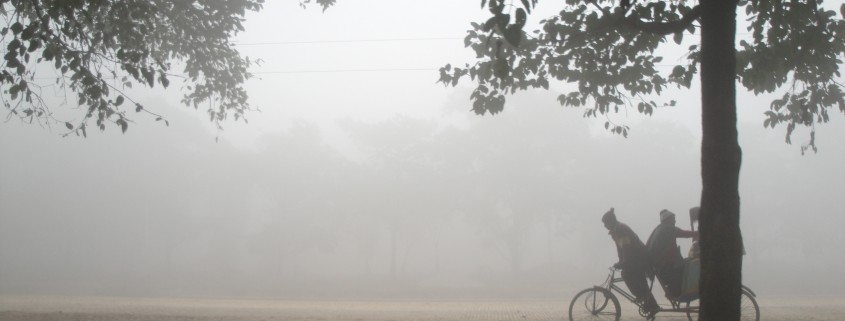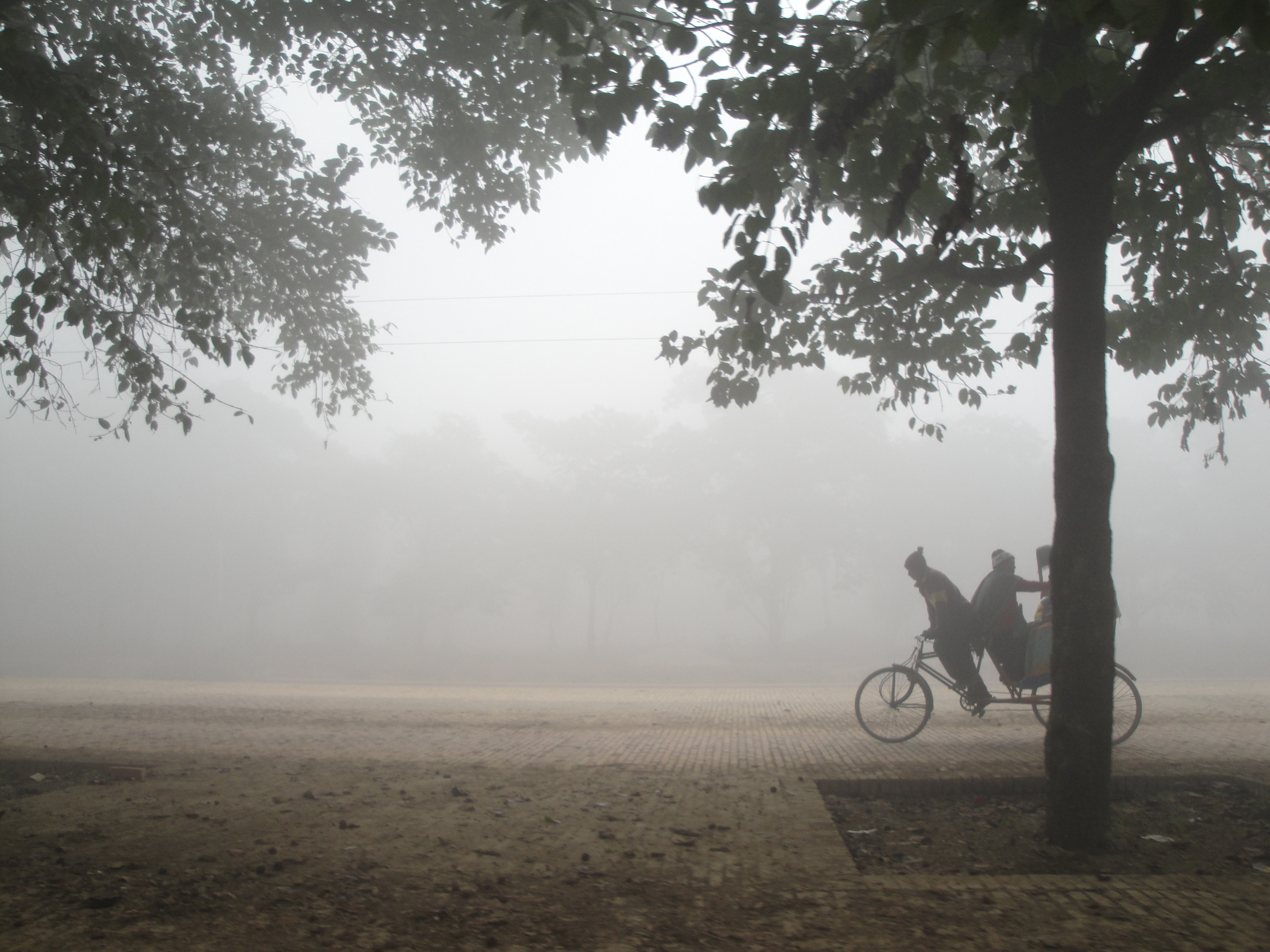Seeking Light in India
The following essay is a chapter I contributed for “Yoga, Philosophy for Everyone Series: Bending Mind and Body”, published by Wiley-Blackwell on November 2011. Book can be found on Amazon.
My decision to quit my job and travel the world came at a unique junction in life. I was single, didn’t have kids, no mortgage, and I was bored silly at my job. I was at rope’s end and felt that my creative soul had fallen asleep. My fire was dimmed low, and I found myself in a dull place in life most of Monday through Friday.
I was seeking something but I couldn’t put my finger on it. I wanted to feel alive, to feel like my life had significance and that moments were inspired by divine meaning. The words of the Persian poet Hafiz haunted me, “I am the flute through which the Christ’s breath flows.” I wanted to feel that way.
One night a vision spontaneously exploded in my mind. I decided that I would quit my job and begin truly following my heart. For many years I had been dreaming of a journey around Asia to explore music, cultures, and peoples. Through most of those years I feared it would never happen. But now the time seemed right and there was nothing to hold me back. The yearning in my heart was so strong I knew that I had to do it. For the first time in a long while, I was ecstatic to be alive. Everything felt right.
Over the next few weeks I sold my car and most of my possessions. What remained, I put in storage. I felt perfectly liberated, free to follow my heart. The East was calling me. Something was waiting for me there. I spent many nights in bed wide-eyed and restless, confident that a breakthrough was waiting for me there. Maybe it was love, maybe I would discover my calling in life, maybe I would find my guru.
The Winding Road to India
The journey was loosely scripted and nothing was cast-in stone. I didn’t even know which countries I would visit, nor how long my trip would be. I bought a one-way ticket to Nepal with a general plan of eventually making it to Thailand. The overarching goal of the journey was to be fully present at all times. I wanted to be in that place where my path was constantly being guided by divine suggestion.
My lofty dreams about the East were shaken soon after the plane touched down in Nepal. Kathmandu is Nepal’s biggest city, and while it is a place of fascinating culture and profound beauty, it is also a crowded, crazy city of pollution and honking cars. I was hoping to find peace and happiness, and yet I was in the heart of chaos. I quickly realized that finding happiness and peace couldn’t be dependent on one’s environment. I needed to find peace within my self.
After a few months of constant movement, I was tired and found myself considering my travels from a further perspective. I had been studying the Lonely Planet guidebook intensely, I visited many temples, trekked through the Himalayas, explored many cities, rented motorcycles and buzzed around visiting tourist attractions. I met many great people and had countless wonderful experiences. But something was still missing. Reflecting on my days back in the office, I found myself still trying to understand the critical question, “What am I looking for?”
For me, part of the intrigue of traveling is experiencing what I can’t find at home. One of the things that had led me to come East in the first place was my desire to find spiritual guidance. Sure, there are churches and wise people to be found everywhere, but as I traveled, over and over, I heard people describing their experiences in India. Their descriptions filled my mind with great visions. They spoke of the myriad ashrams and monasteries where enlightened teachers instructed those who came to learn. They spoke of the sadhus, mystics, yogis, and wandering monks that have called India home for thousands of years. Through all of their stories I was hearing a clear confirmation that India should be my destination. While I really hadn’t been planning on visiting India, and despite my secret fears of such a wild country, all of these surreal descriptions of India’s spiritual heart convinced me that on this great journey, I needed to go there. I thought I would only stay a month or two. Given India’s reputation for profound over-population and general insanity I suspected I wouldn’t want to stay much longer. But I was wrong.
Crossing the border from Nepal into India, I witnessed just how insane India is. It was an exciting kind of insanity, though. The first city I visited was Varanasi, a bustling city in Northern India along the shores of the holy Ganga River. Its narrow stone corridors were busy with pilgrims, cows, dogs, and tourists. There were many temples and shrines in the area and all along the river religious rituals were taking place. Morning, noon, and night several towers of black smoke rose up from funeral pyres where the deceased were being cremated. Despite the chaotic environment, I was struck by the intensity of the Indian spiritual fervor. The spiritual presence was tangible.
In the weeks that followed, India’s lure wrapped its arms around me and held me tightly. Days were long and amazing, filled with countless strange and spontaneous adventures, experiences, and peoples. The landscape was varied and beautiful, the food was incredible, and everyday I had great experiences with inspirational people in random situations.
Many Masters, Many Roads
Traveling in India is tourism unlike anywhere else in the world. There seems to be a certain sort of folk traveling there. Many come with spiritual inclinations and India offers everything they are seeking. The traveler circuit is abuzz with myriad schools of diverse spiritual traditions, including offerings in yoga, meditation, Reiki, Tai Chi, Buddhism, Hinduism, and Ayurveda. Along the course of my travels, I encountered many travelers asking interesting questions, seeking a better understanding of themselves and God, and wondering how their lives were relevant in the grand cosmic picture. I was surprised to find that most travelers were like me, coming to India with hopes of studying with enlightened masters. It excited me greatly to think that there still exists a place on earth where great teachers can be found carrying on the unbroken lineage of ancient wisdom, preserved in an oral tradition, from teacher to student.
Of all the spiritual hotspots along the traveler’s circuit, Rishikesh stood out as a common favorite. I naively suspected Rishikesh had become popular because the Beatles spent time there in 1967 while studying Transcendental Meditation. But as I did more research, I learned that Rishikesh means “land of the sages” and has been for many centuries a holy place where spiritual aspirants come for prayer, meditation, and yoga at its many mountain shrines and ashrams. After five months of traveling around Nepal and India, Rishikesh suddenly seemed like the perfect answer to my soul’s prayer. I wanted to be still and immerse myself in meditation and spiritual inquiry.
After a long, harrowing bus ride north from Delhi, I arrived in Rishikesh. My first impressions were that it’s a pretty typical India city. Cows and dogs were milling about chaotic streets crowded with honking cars, pedestrians, and rickshaws. But then I crossed over a cable footbridge into the spiritual heart of Rishikesh. Surrounded by Himalayan mountains, I stood beside the icy green Ganga River surveying the surreal landscape. Magical Rishikesh and all of her temples and shrines were unfolding before me and as I walked along, I loved it immediately. There was no doubt in my mind that I’d be there a while.
Everywhere I went I saw young fit travelers walking around with yoga mats slung over their shoulders. I soon learned that Rishikesh is the “world capital of yoga” and has many yoga schools offering various flavors of instruction. This intrigued me immensely since I had been wanting to experience traditional yoga in its purest form.
I asked around town and learned of classes with noteworthy teachers. There were many, and so I began sampling various classes. But in each class, I found myself attempting to keep up with the others while lacking an understanding of what or why I was doing these strange things with my body. I felt hopeless, like yoga would never be for me. I looked around the room and saw everyone holding challenging postures effortlessly. Then there was newbie me, clueless, probably making every mistake in the book. I felt like an idiot and was frustrated by my lack of understanding. I just didn’t get yoga. However, as Rishikesh was such a carnival of spiritual wonderment, even if the yoga thing didn’t work out, I was happy to find other ways to spend my days in this enchanted village.
While there, I stayed at the Sri Ved Niketan Ashram. This ashram, like many around India, served dual purposes. It was a guest house as well as a place for spiritual inquiry. I had always had an interest in Hinduism, and this particular ashram offered daily mediation sessions as well as lectures on Vedic Philosophy. I was greatly intrigued and began attending the ashram’s offerings as soon as I got there.
Classes were led by the ashram’s spiritual director, a curious man named Swami Dharmananda. He could be found every morning in the meditation cave sitting in darkness, meditating at the front of the room. Two dozen framed portraits of yogis and saints ranging from Jesus to Shiva adorned the altar at the front of the room. Ten to twenty western and Indian meditators were usually gathered around him, sitting in near darkness with just a dim candle burning in front of the room. Rising well before sunrise in the still of the night, we would gather every morning to learn various techniques for stilling and sharpening the mind.
His lectures were always incredibly interesting as he conveyed the intricacies of Hinduism with precision and decisiveness. He explained how the Bhagavad Gita was the fruit of many wise people searching for truth. It had an organic authorship in that it was the result of knowledge acquired by many searchers through the centuries. Among the practices that evolved under this comprehensive system, Swami Dharmananda spoke in depth about yoga. He explained that one’s diet and actions affect the spiritual body. I was very intrigued by this concept. It made so much sense to me. He also lectured about yoga’s importance in traditional Hinduism, as it provided a framework of meditation, practices and ethics necessary for self-realization. His lectures intensified my desire to connect with yoga. But still I hadn’t found the right teacher.
And then divine intervention happened.
Spiritual Boot Camp
One day I walked into a riverside café and bumped into a friend I’d met a few months earlier in Nepal. I took a seat and we began discussing our time in Rishikesh so far. I mentioned my inability to find the right yoga class. Like a cosmic messenger, he instantly launched into a description of the Agama Yoga School where he had just completed a program.
With great enthusiasm he explained how the school received you as a complete beginner and gave you a foundational understanding of yogic theory, chakras, and the body’s energy channels. The course was a four-week intensive program that combined lectures with asana practice, providing students with a solid grasp of the components that make the yogi’s life a powerful spiritual discipline.
Listening to Alan describe this yoga program, I knew this was the doorway into the yoga experience I had been looking for. And when he mentioned the next course would be starting the following morning, there was no doubt in my mind that I was supposed to be there.
The next day I got up early and, after morning meditation with Swami Dharmananda, I headed off to first day of yoga class. On my clunky Indian bicycle, I rode down the stone path beside the Ganga River, weaving in and out of cows and street dogs and excrement and sadhus strewn along the roads. I found the school on the backside of a temple. The classroom was a concrete room with nothing more than two dozen yoga mats and pictures of yogis and saints on the walls.
I found a mat in the front of the room and closed my eyes for a moment of gratitude and prayed for an open mind. I really wanted to understand how yoga could improve my physical and spiritual life. At the front of the room there was a beautiful Indian man dressed in white, deep in meditation. At 8:30 on the dot, he opened his eyes, stood up, and began teaching.
He was instantly captivating. An intense and incredibly intriguing human being, I just wanted to listen to him. His name was Khushru, and as he spoke, every word found a home in my heart. In my whole life I had never had a teacher that captured my attention more powerfully. The laser beam of his focus never wavered, and he held every single student in the palm of his hand as we listened attentively and processed every word he spoke.
With conviction and eloquence, Khushru instructed us about the wisdom accumulated over hundreds of years by countless spiritual aspirants. His lectures merged Indian Vedanta with western scientific medical findings, philosophy, poetry, and music, creating a patchwork of wisdom gathered from various disciplines throughout the centuries. Even more impressive than his words was his confidence and self-understanding. Clearly, Khushru benefited from the method he was teaching. He was a teacher in the truest sense of the word. He inspired students through his example.
The first week of class was mostly theoretical, with only a few short-sessions of actual yoga practice. Khushru explained how yoga puts the mind and body in resonance with the universe. Devoid of New Age-speak and clichés that always bore me, Khushru’s teachings spanned a wide range of topics, including morality, karma, hygiene, diet, willpower, and meditation. What began as a simple desire to learn asanas evolved into a much larger practice of purifying and managing my mind so that my physical body could become be a sacred vehicle. Kushru’s lectures were riveting and every day I left class feeling like I’d been granted the golden key of understanding.
I was fascinated by the yogic concept of purifying the body and mind via yoga and meditation so one could acquire a healthy balance with the universe. The result of such a practice, Khushru explained, could be seen in the lives of India’s many great yogis. He told us incredible anecdotes of yogis whose lives were spent in complete devotion to God. He spoke of yogis who were known to have performed supernatural feats, like levitating, or appearing in multiple places simultaneously, or having the uncanny ability to see the future and knowing things of which they had no experience. He spoke of Ramikrishna who had spent six months in quasi-lifeless meditation before being conditioned back to life. After all these stories, Kushru summarized that when we become masters of our minds, we exist on a spiritual level where we can actually transcend physical laws.
In the West many of us were raised looking to Jesus as the singularly amazing and Godly individual who walked on water, who defied death, and made miracles happen simply by willing them. These stories made a believer out of me a long time ago, but I never realized that in India these feats were not that extraordinary. Over the course of thousands of years, India has produced many yogis known to have attained enlightenment and self-mastery, with the ability to achieve feats that we in the West call miracles.
The course was designed to encourage us to always be mindful of the spiritual gains of each asana. We learned one new asana everyday. Our instructors demonstrated the physical posture and then imparted a thorough understanding of how each asana affected the chakras and energy channels. When it came time to practice, we held each asana for several minutes, allowing us to sink into a deep state of concentration. The asanas, for the first time in my life, began to resonate with me. I finally felt like I got it—I realized that the quality of my yoga session was not about the attainment of challenging poses, but rather, the mindfulness of my practice.
Breaking Through
During the month-long yoga course, days were long and intense— a kind of spiritual boot camp. Between Khushru’s mind-bending lectures and the demanding asana sessions, I was being challenged to reach further and further into my heart. Sometimes the physical discomfort seemed intolerable, but I was being challenged to recognize sensations as neutral stimuli that our mind characterizes as positive or negative . This was hardcore soul-work for me, but I liked it. And though there were many days when I’d return back to my ashram broken and exhausted, I was happy. My life was changing as the course spoke directly my heart.
With each new day, I began to see how yoga, while not necessarily a religion, was a physical discipline that connects us with our sacred core. It applies scientific truths upon the body as the yogi purifies and strengthens the body and mind. Reflecting on Khushru’s teaching on karma, I was inspired by the notion that every single thing we do, say and think either brings us closer to, or further away, from our ultimate goal of attaining our sacred potential.
Zing! That was it. That was the missing piece. I needed to better understand the sacred life force within us. My yoga practice had effectively conveyed the notion that mindfulness and intention defines our experience in life. Suddenly this concept seemed obvious to me and I realized I had found what I was looking for. There would always be hardship, suffering, and misfortune in our lives, but the yogi transcends negative experience by remaining in the sacred place where all experience is an opportunity for spiritual growth.
A New Day
By the final week of the course, I felt like a new person. I felt like a yogi! I practiced asanas with mindfulness and attention to the spiritual experience. I was training to channel and promote positive energy flow throughout the body. I accepted the fact that that living a truly moral life was a prerequisite to spiritual maturity. The importance of generosity was underscored. The concept of karma was unavoidable. My perception had been expanded from the miniature view of the self as an individual in this disconnected world, to the self’s potential as a complete perfect system, a smaller version of the universe.
I began to understand how all religions lead to the same place. Every tradition’s teachings explain a method through which a practitioner becomes pure and lives in harmony with self and others. Yogic philosophy, like all the great religions, presents an order of the world where the individual is part of the cosmic whole. But unlike most religious teachings, the yogi’s methods are devoid of dogma and jargon. Yoga is simply the science of self-understanding and mastery, that allows one to be happy and live meaningfully.
After my rewarding stay in Rishikesh, I knew in my heart that my journey had come to an end. I felt like the flute Hafiz spoke of, through which the Christ’s breath flows. I knew I had a lot of work ahead of me as I continue to fine-tune the asanas and internalize the teachings, but I knew that whether I was in India or in the US, I was exactly where I needed to be. And that place was good.
_________________________________________________________________________________
This book can be purchased at: http://www.amazon.com/Yoga-Philosophy-Everyone-Bending-Mind/dp/0470658800
For more information about Agama Yoga visit their site at www.agamayoga.com





Leave a Reply
Want to join the discussion?Feel free to contribute!